Final Master Project M2.2 - 2015
KnapZack part 2
Introduction
My Final Master Project is a project of one year that I can direct entirely from my own vision on design. During this project I develop a portfolio tool, called KnapZack, for students of primary schools. KnapZack is designed to integrate within the educational program of primary schools. It allows children to store learning experiences from their point of view, enabling them to look back and reflect upon activities through the use of technology that is available for schools. In schools children develop skills that regular methods prescribe to them. KnapZack is designed so children can explore and develop skills that actually matter to them.
Overall reflection
This project has offered me the opportunities that I needed to show what kind of designer I am. I created a lot of partnerships during this project and these helped me to secure a design process that is strongly connected with the real world. My internship created a realistic scenario of how I could work as a designer after for companies. I was able to relate my design to the wishes and values of the company, but was also able to set out my own project and worked independently. The way I achieved the partnership and involvement of the schools that cooperated in the project was on a level I have never achieved before. I have grown in my skills to perform a design process not just by my self, but also together with these stakeholders.
The project is strongly related on my vision on design by creating a concept that can lead to a transformation in education. It is also a project that is entirely setup by design opportunities that I have found in society. The self-directed nature of this project has also given me the confidence to start my own company to develop KnapZack with my internship company as partner.
Participatory design
The quality of this project is most significant in relation to the participatory design approach. The effort I had put in to find valuable partners to cooperate with really paid out well, especially in my second semester of this project. I cooperated with four schools, but they all had a different role in the project. My activities at Bs het Kleurenorkest were interesting because I learned about how to work with generative tools. The knapzak workshop was my first try-out with this approach, but soon I learned it went quite natural to setup such workshops in later phases of the project. The overview workshop, which took place near the end of my project, worked very well with the teachers and gained me a lot of new insights. Yet is took me much less effort to create this workshop compared with the knapzak workshop.
The opportunity I had at Bs De Meent when I could join the First LEGO League project forced me to find a way to deal with user-testing on a weekly basis. Therefore I needed to make prototypes from the very start of this phase. It was very interesting to learn how much you can achieve by starting simple and adding just small bits to the setup of the user-test. This approach worked so well that the school wanted to continue in 2015. I believe the ability to achieve such an approach in one of the best values I can offer as a designer, especially in the education sector.
The experiment I did with KnapStok also gave me a surprising new insight on my approach of participatory design. When co-creating you have to give the sense of ownership of your design away. I did this when I created the KnapStok and gave it to the kindergarten children to paint it. The creation they made of ‘my’ design was at first even a little bit hart breaking, but later on I realized how valuable the KnapStok had become. I believe that as a designer I have the tendency to control my project, but I learned that sometimes it could be very valuable to be out of control of your design and just see what your users are going to make of it. One thing is for sure; they make something that is really theirs.
Physical prototyping for a digital design
Although I always believed in my concept, I had some doubts how to create a digital design. I think the pitfall of creating a digital design is that you start by limiting yourself when you only create within the frame of a digital screen. At first I didn’t know exactly why, but it felt better to start by creating physical prototypes instead of digital prototypes. When I did, I learned that my approach worked indeed quite well to gain insights beyond the digital interface interaction. On top of that it is much easier to create simple physical prototypes than a digital prototype that you need to program.
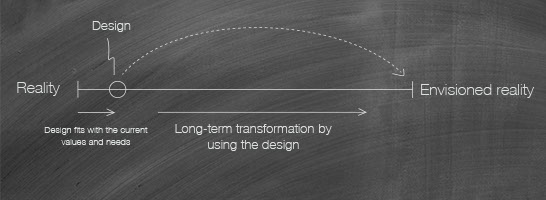
Designing for transformation graphic
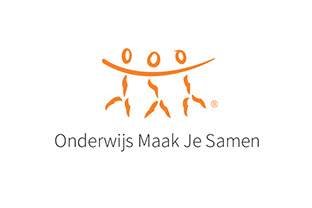
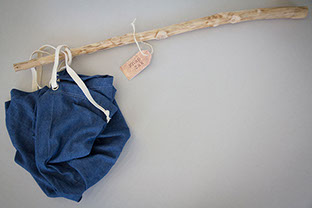
"Knapzak" tool for workshop
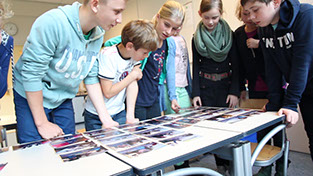
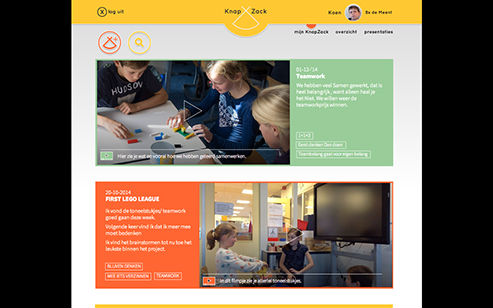

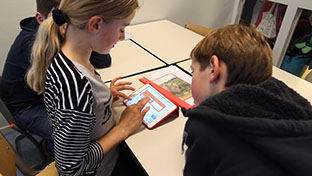
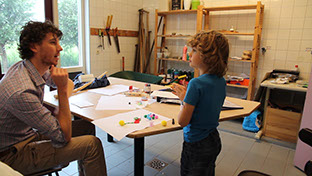
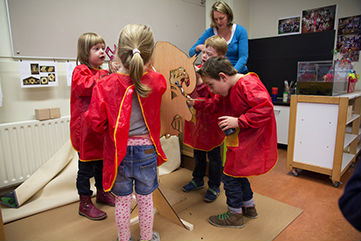
Final design of KnapZack
Using paper prototypes at school
Kindergarten children painting KnapStok
Testing out the KnapZack app
Learning the perception of children during the knapstok workshop
Transformative design
From the start of the project I set out to create a concept that would lead to transformation in the educational sector. During my first semester I discovered what this actually meant from a practical point of view. Therefore it was up to me to actually create a concept that would lead to transformation during my second semester. I learned the key element here is this balance between creating something that represents your innovative vision on a new reality and connecting with the needs and perception of your stakeholders. Too much the first and your design disconnects with the stakeholder, which results in not using your product. (When stakeholder say they will use it does not count.) Too much the second and your stakeholder will use your design, but it does not bring them any further towards innovation.
With KnapZack I achieved that I do connect with the needs and perception of the stakeholder. The consultancies of Onderwijs Maak Je Samen were very enthousiastic and so were the teachers of the schools I cooperated with. More importantly are the children who actually tried out (a simple version of) KnapZack and the essence of the concept simple works. The reactions of the stakeholders does not only shows that they like the concept, but they actually tell me the new opportunities they see if they could use this design. I believe this is the first step to change paradigm of education and is one of the best results for me as a designer to achieve.
As a designer in the education sector
During my project I spoke with a lot of people who work within the education sector and learned how many ideas there actually are to try to improve education from many different angles. Yet is amazed me that with so many ideas, so little is actually done or implemented. Almost every time it stays with talking about the new ideas and new policies that will improve our educational model in the Netherlands. As a designer I have learned to pick up these ideas and create ways to implement this in context. We should start with simple making and doing the proposed ideas instead of keep talking about it. The trade of a designer is exactly that, so I believe there are a lot of opportunities for designers to find work within the field of education.
Reflection on being your own system
The challenge for my with my weekly involvement in the First LEGO League was to find the balance between extensive evaluation of the results of one week and prototyping the next step of KnapZack for the next week. All that needed to be done on top of my other activities of the project. In a later phase I had to choose to take more time to build a digital prototype or else this prototype would be too shallow to use properly in context. I believe I managed ok with the time I had, but I believe in these cases it would be good to work with a small team or at least a partner so to split the tasks, while keeping each other up to date. I do believe that the weekly pace is good in relation to the cooperation with children and the method of being your own system. If there would be too much time between these sessions the use of the KnapZack becomes irrelevant for the users.